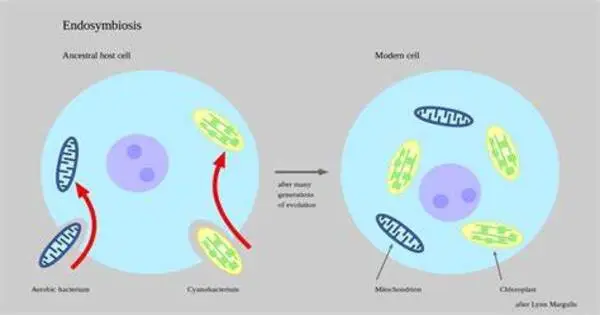An organism that coexists in a mutually advantageous association with the body or cells of another organism is referred to as an endosymbiont. Any organism that coexists, usually but not always in a mutualistic relationship, within the body or cells of another organism is referred to as an endobiont. In the field of biology, this phrase is frequently employed to characterize specific kinds of symbiotic interactions, especially those in which bacteria or other microbes reside inside the cells of a host organism.
The endosymbiotic theory’s tenets form the basis of the idea of endosymbiosis’ historical development. According to the endosymbiotic theory (also known as symbiogenesis), bacteria can only survive in eukaryotic species after being ingested by them. This is well-known because of the idea of organelle formation in eukaryotes. The two main kinds of organelles seen in eukaryotic cells are thought to be derived from bacterial endosymbionts: mitochondria and plastids, which include chloroplasts.
Endosymbiosis (from the Greek: ἔvδον endon “within”, σύν syn “together”, and βίωσις biosis “living”) is the term used to describe this process. Examples are the single-cell algae found inside reef-building corals, the nitrogen-fixing bacteria (known as rhizobia) found in the root nodules of legumes, and the bacterial endosymbionts that give insects vital nutrition.
An organism that coexists in a mutually advantageous association with the body or cells of another organism is referred to as an endosymbiont. In the field of biology, this phrase is frequently employed to characterize specific kinds of symbiotic interactions, especially those in which bacteria or other microbes reside inside the cells of a host organism.
The idea put forth by Lynn Margulis in the 1960s, which holds that organelles found in eukaryotic cells like mitochondria and chloroplasts were originally free-living prokaryotic creatures that were swallowed by ancestral eukaryotic cells, is a well-known illustration of endosymbiosis. These ingested organisms developed a symbiotic association with the host cell over time, eventually changing into organelles that are vital to cellular processes including photosynthesis (chloroplasts) and energy production (mitochondria).
Endosymbiotic connections can be mutualistic, in which the endosymbiont gains benefits from the association with the host, or parasitic, in which the endosymbiont gains benefits at the host’s expense. Numerous creatures, including humans and insects, have developed symbiotic partnerships with bacteria or other microbes that support several facets of their biology, including nutrition acquisition, pathogen defense, and digestion.
















